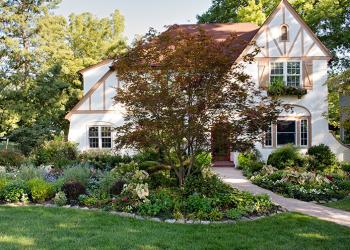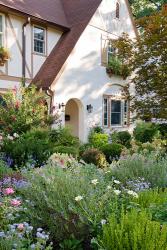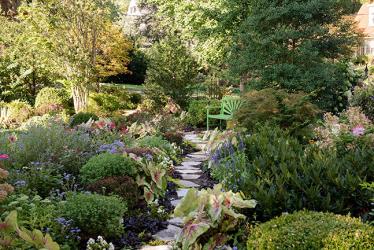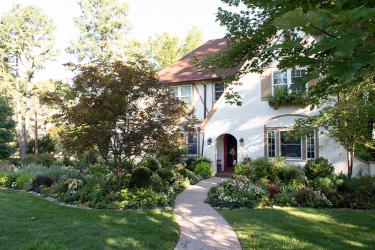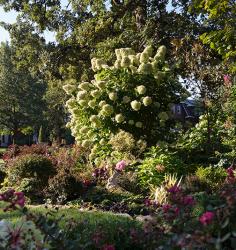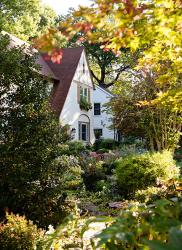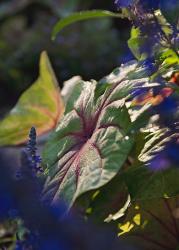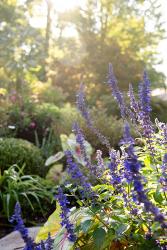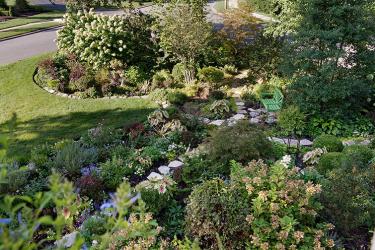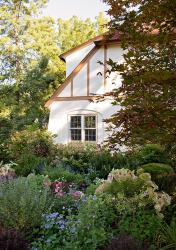There is a decorative oval stone just to the side of the lush, front-yard pathway in Brenda Dribin’s Webster Groves garden. Engraved on it are the words: I am still devoted to the garden. Thomas Jefferson
Writen in 1811 to American portrait artist Charles Willson Peale, this country’s third president, by then retired at his Monticello home, went on to note: “No occupation is so delightful to me as the culture of the earth and no culture comparable to that of the garden.”
Brenda Dribin and Thomas Jefferson have a lot in common. For over 25 years, Brenda has been devoted to her highly visible garden, bordered on three sides by public streets. She has never disappointed the folks who pass by car, bicycle or on foot. The buoyant, brimming, English Country style of the garden perfectly compliments the English Tudor architecture of her home. Stepping-stone pathways wind their way through beds of flowering trees, shrubs and long-blooming perennials. They curve around the side of the house and lead to the back garden, which also borders a public street. The beauty of the garden is such that the Missouri Botanical Garden recently selected Brenda’s garden to be on its next home garden tour.
Although her primary career has been as a health care management consultant focusing on patient care, Brenda gardens with an artist’s eye for color, texture and rhythm. They are techniques, she explains, absorbed by watching her mother. “My mother had a sheer love of gardening. I watched all the pleasure she got,” Brenda recalls. “She taught me about design, color and balance. The first time my mother came here and saw this lot, she said it was made for a garden.”
Originally from Missouri, Brenda had lived in Michigan and Wisconsin before moving back to this area. Gardening here, with the extremes of temperature, was a “big transition,” she says. “This lot was so open. I spent hours pouring over catalogues and books. I learned a lot more about varieties of plants” for the St. Louis climate.
Favorites include the "White Flower Farm" catalogue because of the instruction it provides and "The Well-Tended Perennial Garden" by Tracy DiSabato-Aust. “I give that book to all the young people I know who are just starting to garden,” she says.
She also joined a neighborhood garden club to learn from fellow area gardeners and began ordering caladium bulbs from a Florida grower she learned about from a friend. All have had a huge influence on her garden.
Like all gardens, Brenda’s has evolved. “My front garden used to be shaded and I planted tons of impatiens. Then, 20 years ago we lost a huge maple that was a signature for our house; it anchored the place. I had too much sun for the impatiens. Five years ago, we lost an elm on the side. You re-group.”
Regrouping for Brenda includes changing her gardening philosophy a bit. “I used to collect all kinds of plants; I spent so much money on different things. Now I plant what I know will work and look good.”
She also repeats the same colors and plants throughout her landscape. “I learned from Fine Gardening magazine that you have to have repetition, so your garden doesn’t look like a hodgepodge. Repetition pulls the eye through the garden.” She also believes in a cohesive color palette. “I like a pink and purple cool color palette,” she explains. “If I use something red, it is a bluish red. I think a garden needs that to come together.”
That emphasis extends to the multiple fiberglass containers that dot her landscape, which she paints in one of three different shades of blue to carry an onlooker’s vision throughout the entire space.
One of the plants she depends upon most heavily to provide rhythm and flow to her garden are caladiums, which she orders by the box from Florida grower Caladium World. The giant, heart-shaped leaves in green and white, tinged with rose highlight her garden and provide a cohesiveness that ties together different areas, as the foliage plants thrive in both partial sun and shade.
“I normally plant them around Memorial Day when the soil is already warm. They are so easy to grow. You plant them shallow and they come up quickly. I love to watch them unfurl. It’s like watching spring a second time,” she explains. “I get a box of all different sizes; I don’t think you have to buy jumbo bulbs, but I wouldn’t order all small bulbs.” In years when she has the time, she digs up the bulbs in mid-October to save for the next year.
She enjoys her caladiums most in late summer, when all gardens begin to look tired and burnt out from heat. “They just carry a garden when everything else is gone,” she says.
Blue salvias are a mainstay of her garden as are daisies with marguerite daisies first appearing in spring and long blooming "Becky" daisies taking over in summer. She selects the salvias for their long bloom time favoring a mix of perennial and annual varieties including guaranitica, "Victoria Blue" and “Mystic Spires Blue."
She loves larkspur and has sewed seed throughout her garden. “It was difficult to start,” she admits. “I tried sewing seed in both the fall and in the spring. I also learned that if you try to transplant it, you have to get it in the ground immediately. It is definitely a cool weather crop.” She also allows annual ageratum to self-seed throughout her garden carrying the blue purple color through her landscape in mid-to-late summer. Various varieties of veronica are also favorites.
When it comes to shrubs, Brenda uses a number of types of hydrangeas to anchor her landscape. "Quick Fire," "Limelight," in both large and small versions, and the smaller ‘Bobo’ are spotted throughout. She is also partial to shrubs with purple foliage. Weigelia "Wine and Roses" pops up multiple places. Along pathways you will see ground covers purple-leaved ajuga intertwined with golden creeping jenny.
In addition to her garden and career, Brenda raised two children, both of whom now have their own families and are tending their own gardens. Her husband, Paul, has cheered her on from the sidelines.
“Over the years, I have juggled a lot,” she says. “The garden has kept me going. I love the decorative aspects and the seasons in my garden. People tell me that my garden is always on their walking route. I love that I bring pleasure and joy to people. It is my little gift to the world.”


